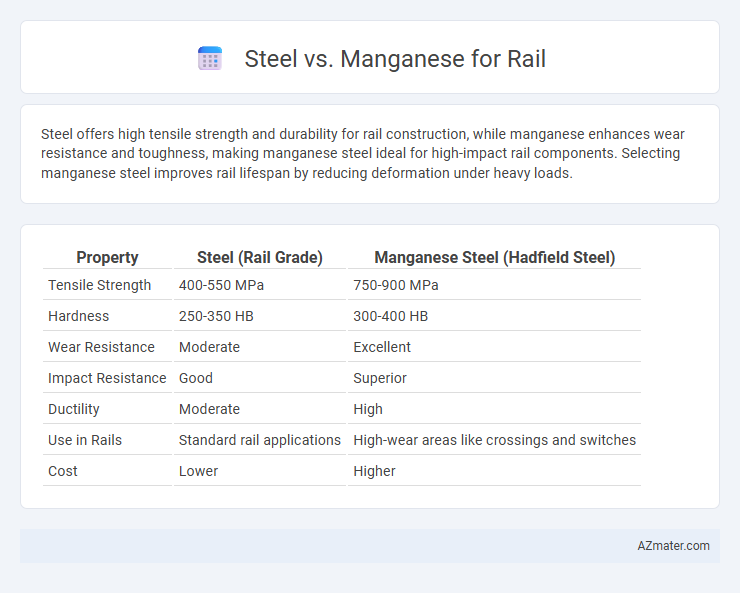Steel offers high tensile strength and durability for rail construction, while manganese enhances wear resistance and toughness, making manganese steel ideal for high-impact rail components. Selecting manganese steel improves rail lifespan by reducing deformation under heavy loads.
Table of Comparison
| Property | Steel (Rail Grade) | Manganese Steel (Hadfield Steel) |
|---|---|---|
| Tensile Strength | 400-550 MPa | 750-900 MPa |
| Hardness | 250-350 HB | 300-400 HB |
| Wear Resistance | Moderate | Excellent |
| Impact Resistance | Good | Superior |
| Ductility | Moderate | High |
| Use in Rails | Standard rail applications | High-wear areas like crossings and switches |
| Cost | Lower | Higher |
Introduction to Rail Material Selection
Rail material selection critically impacts track durability and safety, with steel and manganese alloys being predominant choices. Steel offers excellent tensile strength and wear resistance, while manganese enhances hardness and impact toughness, making it ideal for high-stress rail components. Optimizing rail longevity depends on balancing these materials' mechanical properties with environmental and operational demands.
Steel: Properties and Benefits for Rails
Steel used in rail tracks offers exceptional tensile strength and durability, essential for supporting heavy loads and withstanding constant wear and tear. Its high carbon content enhances hardness and resistance to deformities, ensuring longer rail lifespan and reduced maintenance costs. Moreover, steel's excellent weldability and recyclability contribute to efficient installation and sustainable rail infrastructure development.
Manganese: Properties and Benefits for Rails
Manganese is a critical alloying element in rail steel, enhancing hardness, tensile strength, and wear resistance, which significantly improves rail durability under heavy loads and high-impact conditions. Its ability to increase toughness minimizes the risk of rail fractures and deformation, making it ideal for high-stress rail applications such as heavy freight and high-speed trains. The inclusion of manganese in rail steel also contributes to better fatigue resistance and longer service life, reducing maintenance costs and downtime.
Comparative Wear Resistance: Steel vs. Manganese
Manganese rail steel exhibits superior wear resistance compared to standard carbon steel due to its high impact toughness and work-hardening ability under repeated stress. Steel rails, typically made from medium to high carbon grades, provide strength but lack the self-strengthening characteristic that manganese alloys offer during service. The enhanced durability of manganese rails reduces maintenance frequency and extends service life in high-impact rail environments such as heavy-haul freight lines.
Cost Analysis: Steel Rails vs. Manganese Rails
Steel rails generally incur lower initial costs compared to manganese rails, making them a preferred choice for budget-conscious rail infrastructure projects. Manganese rails, while more expensive upfront due to their alloy composition, offer significantly higher wear resistance and longer service life, reducing maintenance and replacement expenses over time. Cost analysis must consider the total lifecycle expenses, where manganese rails present better long-term value despite higher initial investment.
Durability and Longevity in Rail Applications
Steel rails offer high tensile strength and wear resistance, making them reliable for supporting heavy loads and enduring constant use in rail applications. Manganese-enhanced steel alloys improve durability by providing superior hardness and impact resistance, especially beneficial in high-stress areas such as rail crossings and curves. The combination of manganese within steel composition extends rail lifespan by reducing deformation and wear, ensuring longer service intervals and reduced maintenance costs.
Maintenance Requirements and Lifespan
Steel rails typically require more frequent maintenance due to their lower resistance to wear and deformation under heavy loads, leading to higher lifecycle costs. Manganese steel, with its superior hardness and impact resistance, significantly reduces rail wear and lengthens service intervals, thus extending rail lifespan. Longevity of manganese rails can be up to 50% greater than conventional steel, making them ideal for high-traffic rail networks needing minimal maintenance downtime.
Environmental Impact and Sustainability
Steel rails, primarily made from carbon steel, offer high durability and recyclability, significantly reducing environmental impact through efficient reuse in rail infrastructure projects. Manganese, often alloyed with steel to enhance hardness and wear resistance, can improve rail longevity but involves energy-intensive mining and processing, leading to a higher carbon footprint compared to pure steel rails. Sustainable rail production favors steel with optimized alloy content to balance performance and environmental costs, minimizing resource extraction and promoting life cycle recycling to reduce greenhouse gas emissions.
Suitability for Different Rail Environments
Steel rails, typically composed of carbon steel or alloy steel, offer high strength and durability, making them ideal for general rail applications and heavy freight lines where load-bearing capacity is critical. Manganese steel, known for its exceptional toughness and resistance to wear and impact, excels in high-stress environments such as rail switches, crossings, and tracks exposed to frequent abrasion and shock loads. The suitability of steel versus manganese for rail environments depends on specific operational conditions, with manganese steel preferred for sections requiring enhanced wear resistance and toughness under dynamic forces.
Conclusion: Choosing Between Steel and Manganese for Rails
Choosing between steel and manganese for rails depends primarily on durability requirements and operational conditions. Manganese steel offers superior wear resistance and impact toughness, making it ideal for heavy loads and high-impact environments, while standard steel provides cost-effective performance with sufficient strength for moderate conditions. Evaluating factors like load intensity, maintenance frequency, and budget ensures the optimal material selection for rail infrastructure longevity and safety.

Infographic: Steel vs Manganese for Rail
 azmater.com
azmater.com